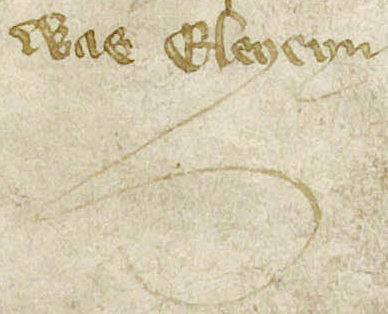|
| A |
 | Usage: departen
both secretary and anglicana lower case 'a' are employed by this scribe. |  | Usage: hath |
 | Usage: And
one of the scribe's upper case 'A' graphs with squarish lower lobe. |  | Usage: As
the second, and most representative graph on these two folios has an exaggerated squarish lower lobe. |
|
| D |
 | Usage: day
conventional looped 'd' is used throughout. |  | Usage: aspied
'd' in final position with descending tag. |
 | Usage: blood
the loop of 'd' sometimes extends back over previous letters. |  | Usage: Destroyed
upper case letter at the beginning of a line. |
|
| G |
 | Usage: conynge
anglicana double compartment 'g' is the preferred graph but secretary 'g' is also used frequently. |  | Usage: degree
tailed 'g' with long tail extending beneath several other letters. |
 | Usage: Griece
upper case 'G'. |  | Usage: thyng
'g' with much more pointed lower lobe and hairline stroke closing both upper and lower compartments. |
|
| H |
 | Usage: that
the limb descends in a slight curve. The tail-stroke then angles sharply to the right in almost every example of the scribe's 'h'. | | Usage: wuch
crossed 'h' in 'ch' combination. |
 | Usage: he
a flamboyant 'h' on the top line of verse. |  | Usage: He
upper case letter at the beginning of a line. |
|
| R |
 | Usage: Destroyed
modern 'r' is used for preference in all positions. |  | Usage: Troy
long 'r' may occasionally be found. |
 | Usage: for
'z'-shaped 'r' follows 'o' and has a long otiose stroke attached which curves round counter-clockwise to follow the line of the graph. | | |
|
| S |
 | Usage: this
kidney 's' is used for preference in final position. |  | Usage: fals
sigma 's' also used in final position as well as initially. |
 | Usage: scornyng
long 's' is used initially and medially. |  | Usage: So |
|
| W |
 | Usage: wist
the 'w' graph is fairly consistent with looped head, angled feet to the limbs and the 'B'-shaped element to the right. |  | Usage: whan |
 | Usage: was
the left limb is separate in this example. |  | Usage: Wherfore
upper case letter at the beginning of a line. |
|
| Y |
 | Usage: Troy
the scribe frequently reverses the tail of 'y' with the same sharp angle which he employs on 'h'. |  | Usage: youre
the scribe needs no excuse to extend tails, add extra flourished otiose strokes to almost any letter at the end of a word or line including 'e', 'n', 'h' and 'y'. |
 | Usage: was Eleyeyn
the tail of the first 'y' may be seen extending way down into the lower margin. | | |
|
| Upper Case Letters |
 | Usage: So
first letter of first line of folio. |  | Usage: Thorugh |
 | Usage: Now |  | Usage: Criseide |
|
| More Upper Case Letters |
 | Usage: And
he first letter of the first line of the folio. |  | Usage: In
first letter of a stanza. |
 | Usage: But | | |






































